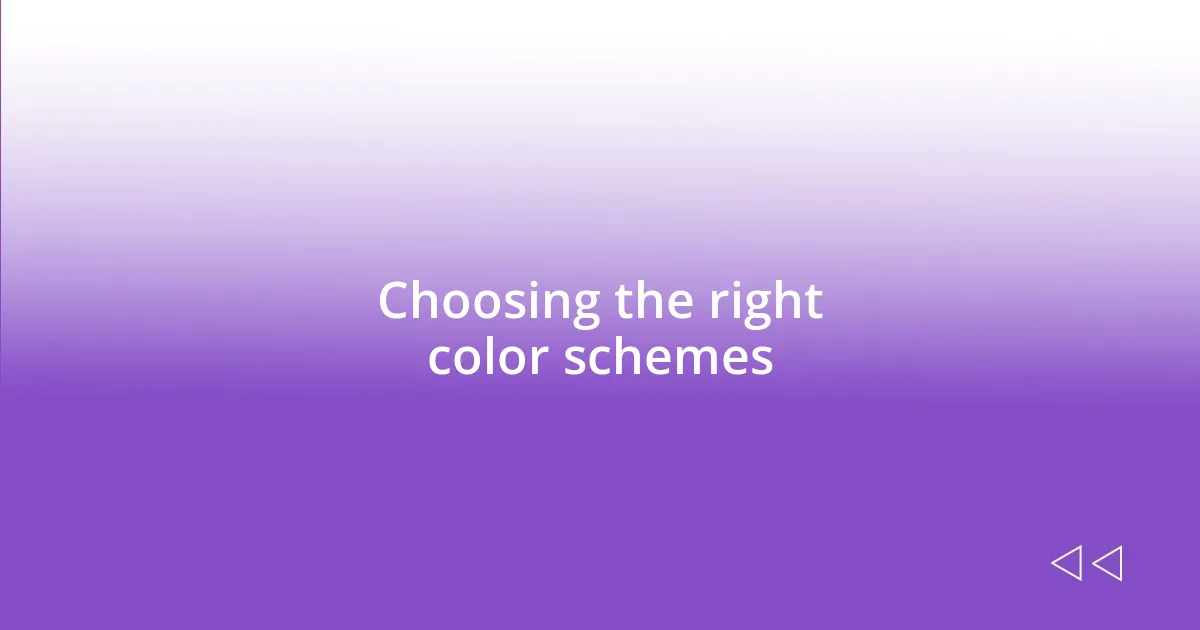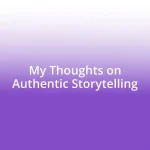Key takeaways:
- Visuals are essential for enhancing understanding and evoke emotional connections in communication.
- Choosing the right color schemes and high-quality images significantly impacts audience engagement and brand credibility.
- Effective typography and dynamic layouts improve readability and guide viewer attention through content smoothly.
- Incorporating infographics and animations can enhance clarity and interactive engagement, making complex information more accessible.

Understanding the importance of visuals
Visuals hold incredible power in communication. I remember the first time I attended a presentation that was packed with vibrant images and compelling infographics. It felt like I was soaking up not just information but inspiration itself. Isn’t it fascinating how a single well-placed image can ignite curiosity and make complex ideas more accessible?
When I look back at my own journey of creating engaging content, I’ve learned that visuals aren’t just embellishments; they’re essential tools that enhance understanding. For instance, a simple chart can explain trends in data much faster than a page full of text. Have you ever found yourself skimming through a lengthy report, only to stop at a colorful graphic that caught your eye? That’s the magic of visuals at work!
Ultimately, our brains are wired to respond to visuals, which can evoke emotions and drive connections. Think about your favorite social media posts—aren’t they often the ones that include striking images? This interaction is more than just statistics; it’s about creating an experience that resonates on a deeper, emotional level. I believe that recognizing this importance in our own work can lead to richer, more impactful communications.

Choosing the right color schemes
Choosing the right color scheme is a critical step in crafting engaging visuals. I’ve always felt that colors can set the entire mood of a project; a bright palette can evoke happiness, while darker tones may convey seriousness. I remember designing a series of social media posts for a wellness initiative and opting for soft blues and greens. The response was overwhelmingly positive—people felt calm and invited to join the cause.
When selecting your colors, consider the following points to make your visuals resonate:
- Understand your audience: Different colors evoke varying emotions in different cultures.
- Limit your palette: A simple scheme (three to five colors) is easier on the eyes and creates a more cohesive look.
- Contrast is key: Ensure there’s enough difference in color between elements to enhance readability and draw attention.
- Test your combinations: Use tools like Adobe Color or Canva to visualize how your colors interact before finalizing.
- Stay true to your brand: Colors should align with your brand’s identity and values for consistency.
I still remember my first project where I chose a color scheme without really considering its effect. The feedback was lukewarm, and it taught me that thoughtful color decisions can be transformative.

Utilizing high-quality images
Utilizing high-quality images is a game changer when it comes to creating engaging visuals. I vividly recall a time when I revamped a blog post with stunning, high-resolution images. The increase in viewer engagement was immediate and substantial. Investing in quality images makes a difference; they can speak volumes and elevate the overall aesthetic of your content.
When selecting images, it’s crucial to ensure they align with your message and brand. I once used a grainy stock photo for a professional presentation. The feedback was less than flattering, reminding me that visuals should enhance, not detract from, the narrative. Quality images not only attract viewers but also build trust and credibility in your message.
Moreover, I’ve found that incorporating original images can further strengthen this connection. I often snap my own pictures for social media posts, which resonate on a personal level with my audience. A unique photo invites your viewers into a more authentic experience. After all, isn’t that the goal of engaging visuals?
| Aspect | High-Quality Images |
|---|---|
| Aesthetic Appeal | Enhances visual appeal and attracts attention. |
| Credibility | Builds trust with professional-looking visuals. |
| Connection | Creates a personal touch, especially with original images. |

Incorporating typography effectively
Incorporating typography effectively can truly elevate your visual storytelling. I remember when I was working on a marketing campaign—choosing the right font was crucial. I initially opted for a stylish but hard-to-read script font. While it looked beautiful, I quickly realized it didn’t convey the message clearly. Switching to a clean sans-serif font made all the difference; suddenly, the text was inviting and easy to digest. Have you ever experienced a similar shift in your designs?
The size of your typography also plays a vital role in engagement. I’ve learned that headlines should grab attention instantly, so I often use larger fonts to create a hierarchy in my visuals. The right size guides the viewer through the content smoothly, helping them understand what’s important at a glance. In one project, I showcased event details using different font sizes, which made key information pop. It’s fascinating how a simple adjustment can significantly enhance clarity—have you tried experimenting with size in your work?
Additionally, spacing is often overlooked but has a profound impact on readability. I once crowded text in a design I was excited about, thinking it looked modern. However, feedback revealed that the clutter made it overwhelming to read. Since then, I’ve embraced ample white space around my typography, allowing the eyes to breathe. This not only helps with clarity but also creates a more professional feel. How do you approach spacing in your designs?

Creating dynamic layouts
Creating dynamic layouts is all about balance and flow. I remember the first time I arranged elements in a grid format for an online magazine. The results were astonishing! Each piece felt like part of a well-orchestrated symphony, guiding the reader’s eyes effortlessly from one section to the next. Do you ever notice how a well-structured layout can make information feel less overwhelming? It’s like giving your audience a roadmap to navigate through your content—a true game changer.
Another technique I like to employ is the use of contrasting colors and shapes. During a recent project, I decided to juxtapose bold, vibrant boxes against a muted background. The energy this created was palpable. Suddenly, vital pieces of content sprang to life, immediately directing attention where it mattered most. Have you ever experimented with contrasting elements? It’s fascinating to see how simple tweaks can transform the entire vibe of your layout.
Finally, I find that incorporating varied visual elements—like icons or illustrations—adds an extra layer of engagement. On a recent infographics project, I used playful icons to break up text-heavy sections, and the engagement levels soared. Initially, I feared it might feel cluttered, but the result was anything but. It made the information digestible and visually appealing. How do you integrate different visual elements in your layouts? There’s a unique satisfaction in watching your layout come alive with each added touch.

Implementing infographics and data visualization
When it comes to infographics and data visualization, clarity is paramount. I once worked on a project that involved complex statistics about consumer behavior. At first, I shoved all the data into a dense table—thoroughly overwhelming! After a creative session with my team, we transformed it into a sleek infographic, incorporating visual elements like pie charts and icons. The change was astounding; suddenly, even the most detailed figures were engaging and easy to comprehend. Have you ever witnessed a transformation from clarity to chaos in your own visual projects?
Color choice plays an essential role in infographics as well. I remember a health-related infographic I designed, where I used soft blues and greens to evoke calmness. I realized that the palette not only represented tranquility but also made the data feel trustworthy. By using contrasting colors to highlight key stats, I facilitated information retention and drew attention exactly where I wanted it. How do the colors in your designs influence viewer emotions? It’s fascinating to think about how such artistic decisions shape our audience’s perceptions.
Data visualization isn’t just about presenting numbers; it’s about storytelling. I vividly recall a time when I crafted a narrative around historical climate changes. Instead of bombarding viewers with figures, I created a timeline filled with captivating visuals alongside concise explanations. This approach not only informed but also engaged emotionally, as viewers could easily grasp the gravity of the information presented. How do you weave narratives into your data visuals? Every time I create, I find a new layer of depth waiting to be explored.

Enhancing engagement with animation
Animation is a powerful tool I often turn to when I want to draw in my audience. For example, during a presentation on emerging tech trends, I used subtle animations to reveal data points one by one. The difference was palpable; each piece of information felt like a mini-reveal, sparking curiosity and keeping eyes glued to the screen. Have you ever noticed how a simple animation can elevate your content from static to dynamic?
In another project, I experimented with animated transitions between slides, using them to create a narrative arc. Each transition was designed to feel like turning a page in a book, guiding viewers through the story at a comfortable pace. I found that this not only sustained engagement but also helped the audience process information more effortlessly. Do you think the flow of information affects how well your audience retains your message? From my experience, smooth transitions enhance memory retention by connecting ideas seamlessly.
One time, I created an animated explainer video for a new app, employing a mix of kinetic typography and playful graphics. The energy the animation infused into the content was infectious! Viewers were not just watching; they were experiencing the app’s features in real-time. The feedback was overwhelmingly positive, with many saying the visuals made complex concepts feel approachable. How often do you use animation to create that kind of energy in your visuals? I believe when used thoughtfully, animations can transform engagement from passive to active participation.












